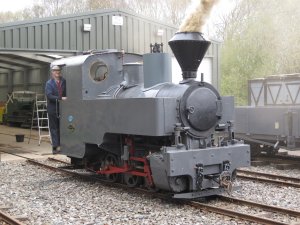This loco was ordered by the French Commission for their artillery railways, and was delivered new to Nantes, France. The French military acheived considerable standardisation in the locomotives which they used to support their operations during World War One.
This loco, although built in Stoke by Kerr Stuart, is very similar to locos built by the French company Decauville; it seems highly likely that the French issued Kerr Stuart with the design drawings. Kerr Stuart built 70 locos of this type. After the war, it was sold from Verdun to a dealer, Brunner & Marchand of Borray, Seine & Oise. In October 1930, it was sold on to Societe Anonyme des Carrieres de la Valee Heureuse et du Haut Banc, Marquise Rinxent in the Pas de Calais area of northern France. This was a stone quarry, and had at least four other similar locos. By August 1956, the locos on this site were derelict. It was repatriated to the UK onboard the ferry “Free Enterprise VII” on 11/10/74.
It was moved to the abortive museum project at Pen-yr-Orsedd quarry, North Wales, and then on to the Gloddfa Ganol slate quarry museum complex, near Blaneau Ffestiniog. Here, it was mounted on a plinth by the museum operator’s house, and became a familar site to passing motorists as they struggled up the lengendary Crimea Pass road out of Blaneau to the north. Following closure of the Gloddfa Ganol museum, the loco joined the MRT collection on 10/3/98. Its restoration was completed in time for the September Gala at Apedale in 2011.
Why was the Joffre Class Produced?
The Joffre design was very different to Kerr Stuart’s usual designs, which had many common parts and features. A key aspect of their manufacturing operation was that stocks of parts were available and locomotives could be assembled and delivered at short notice. The Joffre design arose solely due to a requirement of the French Government’s Commission Internationale de Ravitaillement, also known as the Mission Hauser, for their Artillery Railways.
Unlike the British, the French achieved significant standardisation of locomotives for their tactical light railways. Between September 1914 and November 1918 they took delivery of 320 identical 8 ton Decauville 0-6-0 side tank locomotives. Nevertheless, supplies were limited, and thus assistance was sought from British manufacturers, resulting in an order with Kerr Stuart to the same specification as the Decauvilles. All the basic dimensions were identical, including the appearance of the cab and side tanks, and the layout of the boiler and sanding gear. The extent of the similarity appears to indicate that Kerr Stuarts were provided with working drawings by the French Government, or at least detailed specifications. The most obvious difference to the Decauville design was the addition of a distinctive spark-arresting chimney.
In total, seventy locos were supplied by Kerr Stuart in three batches:
Batch 1 (1915) Nos. 2402 – 2416
Batch 2 (1915) Nos. 2428 – 2457
Batch 3 (1916) Nos. 2995 – 3019
Some sources indicate that the original order was for 100 locomotives and it appears that Kerr Stuarts, anticipating a further order, manufactured additional parts which were not eventually needed. The stock of surplus parts led to the design of an additional locomotive class, the Haig, which was externally very similar to the Joffre, but without the well tank. The Quarry locomotive “Sergeant Murphy” was a Haig, and dramatically exhibited the consequent stability problem at Penrhyn when it overturned, fatally injuring its driver in 1932.




